
Penstemon digitalis is a species of flowering plant in the plantain family, Plantaginaceae. The flowers are white and are borne in summer. It is native to eastern Canada and the eastern and southeastern United States. Penstemon digitalis is the most widespread species of Penstemon east of the Mississippi River.
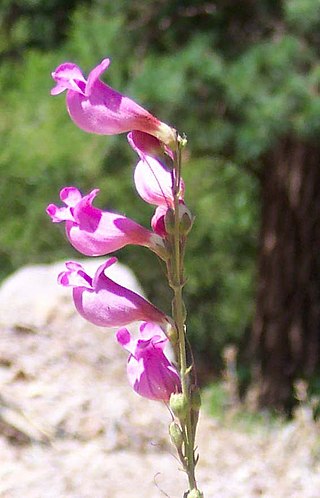
Penstemon floridus is a species of flowering plant in the plantain family known by the common names Panamint beardtongue and rose penstemon.

Penstemon heterophyllus is a species of penstemon known by the common names bunchleaf penstemon, foothill penstemon, and foothill beardtongue. It is endemic to California.
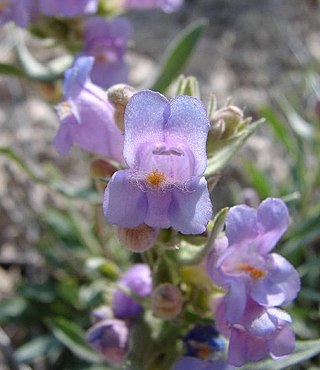
Penstemon janishiae is a species of penstemon known by the common names Antelope Valley beardtongue and Janish's beardtongue. It is native to the northwestern United States in sections of Idaho, Oregon, Nevada and northwestern California, where it is a member of the flora in sagebrush, woodland, and pine forests. It is a perennial herb with several hairy upright stems reaching up to about 25 centimeters tall. The leaves are up to 6 centimeters long, many located around the base of the plant and several pairs along each stem. The inflorescence produces several wide-mouthed tubular flowers 2 to 3 centimeters long. Each hairy, glandular flower is pale purple to pinkish or bluish in color with a dark-lined, pouchlike throat. The mouth of the flower is hairy and the protruding staminode is coated in bright orange or yellow hairs.
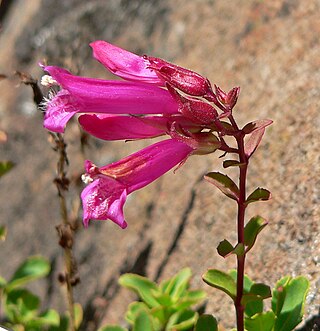
Penstemon newberryi is a species of penstemon known by the common name mountain pride or Newberry's penstemon. It is native to the mountains of northern California, Oregon, and Nevada, where it grows in rocky habitat, often at high elevation, such as talus. It is a bushy, mat-forming subshrub growing up to 30 centimeters tall. The leaves are mostly basal on the plant, oblong or oval and toothed, measuring 1 to 4 centimeters in length, with a few smaller pairs along the stem. The glandular inflorescence bears showy magenta flowers 2 to over 3 centimeters in length. The flower is generally tubular or funnel-shaped and has a coating of short to long and curly hairs in the mouth and on the staminode.
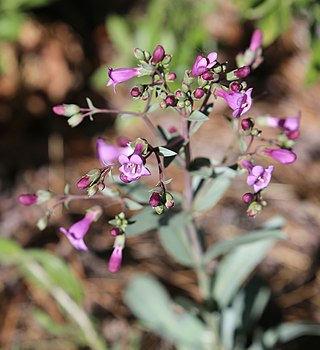
Penstemon patens is a species of penstemon known by the common name Lone Pine beardtongue. It is native to the central Sierra Nevada of California and slopes and plateau to the east, its distribution extending just into Nevada. It grows in forest, woodland, and scrub habitat types. It is a perennial herb producing hairless, waxy stems up to about 40 centimeters tall. The thick, lance-shaped, gray-green, opposite leaves are up to 9 centimeters long and 2 wide. There are usually many leaves clustered around the base of the plant and smaller pairs higher on the stem. The inflorescence bears wide-mouthed tubular flowers up to 2 centimeters long with corollas in shades of lavender to magenta. The flower is mostly hairless except for the staminode which may have a coat of orange or yellowish hairs.
Penstemon personatus is an uncommon species of penstemon known by the common name closethroat beardtongue.

Penstemon pseudospectabilis a species of penstemon. It's native to the southwestern United States, where it grows in desert and plateau habitat types, such as sandy washes, scrub, and woodland. The plant is generally a shrub growing to one meter, with many erect stems. The thin leaves are oval with wide, pointed tips and serrated edges. They are arranged oppositely in pairs, many are completely fused at the bases about the stem, forming a disc. The inflorescence bears tubular flowers with expanded, lobed mouths and glandular hairs on most surfaces, except the hairless staminode. The flower grows to 2.5 centimeters and is reddish pink.

Penstemon spectabilis is a species of penstemon known by the common name showy penstemon or showy beardtongue. It is native to southern California and Baja California, where it grows in the chaparral, scrub, and woodlands of the coastal mountain ranges.

Penstemon utahensis is a species of penstemon known by the common names Utah beardtongue and Utah penstemon. It is native to the southwestern United States, where it grows in scrub, woodland, and canyons. It is a perennial herb growing erect to a maximum height near half a meter. The thick leaves are located around the base of the plant and in opposite pairs along the stem. The upper leaves are lance-shaped and often folded lengthwise, measuring up to 5.5 centimeters long. The showy inflorescence bears many bright red-pink flowers up to 2.5 centimeters in length. They are cylindrical, tubular, or funnel-shaped with wide, lobed mouths, and mostly hairless to slightly hairy and glandular.
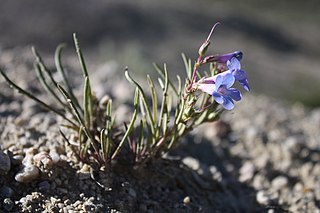
Penstemon penlandii is a rare species of flowering plant in the plantain family known by the common names Penland penstemon and Penland's beardtongue. It is endemic to Colorado in the United States, where it is known only from a strip of land about five miles long in central Grand County. There are two occurrences totalling about 8600 individuals. This is a federally listed endangered species of the United States.

Penstemon barrettiae is a species of flowering plant in the plantain family known by the common name Barrett's beardtongue or Barrett's penstemon. It is endemic to a small part of the Pacific Northwest of North America.
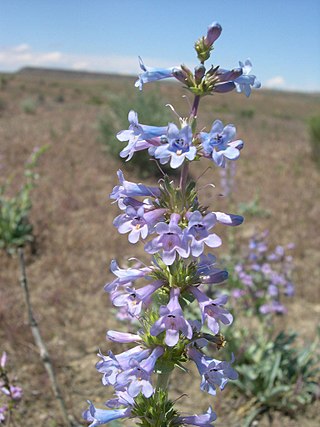
Penstemon acuminatus is a species of flowering plant in the plantain family known by the common names sharpleaf penstemon and sand-dune penstemon. It is native to the northwestern United States, where it occurs in Washington, Oregon, Idaho, Utah, and Nevada.

Penstemon cyaneus is a species of flowering plant in the plantain family known by the common names blue penstemon and dark-blue beardtongue. It is native to the western United States, where it is widespread in Idaho, Montana, and Wyoming.

Penstemon eriantherus is a species of flowering plant in the plantain family known by the common names fuzzytongue penstemon and crested beardtongue. It is native to western North America, where it occurs in western Canada and the northwestern and north-central United States.

Penstemon tenuis is a species of flowering plant in the plantain family known by the common name sharpsepal beardtongue. It is endemic to Texas, Louisiana, Mississippi, and Arkansas in the United States where it is found in open, damp areas in alluvial soil. It flowers from early April into early June.

Penstemon virens, commonly known as blue mist penstemon, Front Range beardtongue, or Green beardtongue, is a common Penstemon in the Front Range foothills in Colorado and Wyoming. The dainty flowers are an ornament to many rocky or sandy area within its range. It is confusingly similar to Penstemon humilis and Penstemon albertinus though the ranges of these plants do not overlap in the wild. The common name, blue mist penstemon, refers to the cloud of flowers on multiple stems facing every direction.

Penstemon ambiguus, commonly known as the bush penstemon, pink plains penstemon, or gilia beardtongue is a species of Penstemon that grows in the shortgrass prairies and deserts of the western United States and northern Mexico. This bush like penstemon grows in sandy, loose, and creosote soils and is particularly known for the spectacular flowering show it produces, sometime seasons turning whole hillsides bright pink–white.

Penstemon auriberbis, commonly known as the Colorado penstemon or Colorado beardtounge is a species of Penstemon that grows in the shortgrass prairies of southern Colorado and in a few places in northern New Mexico. Although specimens were collected on the 1820 expedition by Stephen H. Long through the area, they were not scientifically described as a separate species until 1920.
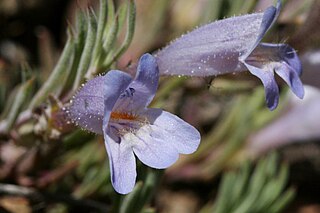
Penstemon caespitosus, commonly known as mat penstemon, is a summer blooming perennial flower in the large Penstemon genus. It is a widespread plant from near timberline to the foothills in the Southern Rocky Mountains and Colorado Plateau in North America. It is noted for its ground hugging growth habit and as a plant used in xeriscape and rock gardening.




















